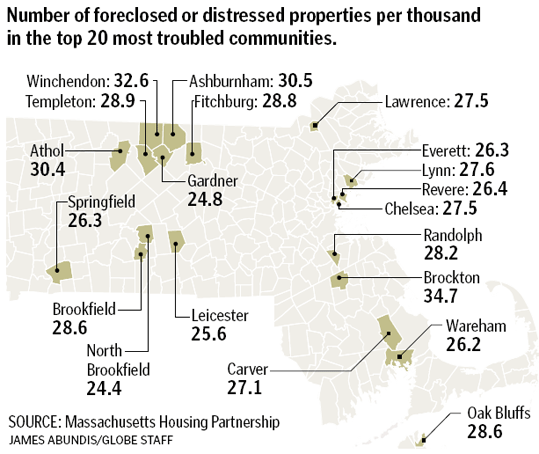For the first time, more home foreclosures are taking place in the state’s suburban and rural communities than in long-troubled cities, according to a new study by the Massachusetts Housing Partnership.
The shift, which has occurred over the last year, shows that a persistently high unemployment rate and the stagnant economy have become major drivers of bank seizures in Massachusetts, the study found. That contrasts with the wave of foreclosures that first swept cities in 2007, a crisis largely sparked by high-interest mortgage loans, high-risk borrowers, and plummeting property values.
“What we are seeing is the long-term trend away from the inner city areas,’’ said Tim H. Davis, author of the report by the housing partnership, a public nonprofit group that works to promote affordable housing. “Subprime lending was the primary and early cause of lending problems and foreclosures in the urban areas. In the more suburban areas it is much more likely to be tied to unemployment and the general economy.’’
The study found that as of Oct. 1, Boston and 24 “gateway’’ communities including Worcester and Springfield, accounted for 49 percent of the state’s housing units either going through the foreclosure process or already seized by a bank — down from 54 percent a year ago. Gateway communities are defined as urban areas whose residents have lower than average incomes and education levels, the report said.
But now, the majority of distressed or bank-owned properties are located throughout scores of the state’s outlying communities. For instance, the rural towns of Winchendon, Ashburnham, and Athol have some of highest concentrations of foreclosures in the state, according to the report.
“This problem is affecting more than just the lowest income communities,’’ said Barry Bluestone, dean of the School of Public Policy and Urban Affairs at Northeastern University, who called the increase in foreclosures outside the state’s cities “dramatic.’’
Some cities that have long suffered because of foreclosures — including Lawrence, Chelsea, and Springfield — had a lower percentage of home-takings over the last year, according to the report. Brockton still tops the list with the highest concentration of distressed or foreclosed properties — 34.7 housing units per thousand.
Overall, foreclosures in Massachusetts continue to increase. The number of properties in the foreclosure process or already bank-owned increased from 12.9 housing units per 1,000 in October 2009 to 13.7 units per 1,000 this October, the report said.
Bluestone said the report shows policy makers must do more to help struggling families in all parts of the state to save their homes just as they work to revive neighborhoods plagued by abandoned buildings. “We still need to boost the economy, we need to get people jobs,’’ he said.
Paul Willen, a senior economist at the Federal Reserve Bank of Boston, said the foreclosure crisis is slowing in cities largely because subprime lending stopped around 2006 and by now most of those borrowers have already saved or lost their homes. “It’s now prime loans where all the new foreclosures are happening,’’ he said.
The report did not come as a surprise to many housing activists and economists who have been watching the steady seep of foreclosures into the suburbs. To reach more troubled homeowners, members of the Jamaica Plain-based community activist group City Life/Vida Urbana recently headed out of the city to rallies in Randolph and Stoughton.
“There are a lot of people in suburban locations who are deeply underwater,’’ said City Life community organizer Steve Meacham, meaning their mortgage balance exceeds the value of their home. “Those people are not being served by the loan modification process.’’
The federal Department of Housing and Urban Development also unveiled a plan this year to provide bridge funds to eligible borrowers who have lost their jobs and can’t cover mortgage payments. But the federal government has yet to provide more details about the program, leaving many homeowners desperate for more information.
Local housing advocate Lewis Finfer said programs to assist homeowners have largely failed because lenders are not required to do anything.
“This is the continuing and deepening of the foreclosure crisis,’’ said Finfer, executive director of Massachusetts Communities Action Network, a faith-based group that works to support community organizations. “There is no way these numbers are going to turn around soon.’’
Jenifer B. McKim Boston Globe November 11, 2010

No comments:
Post a Comment